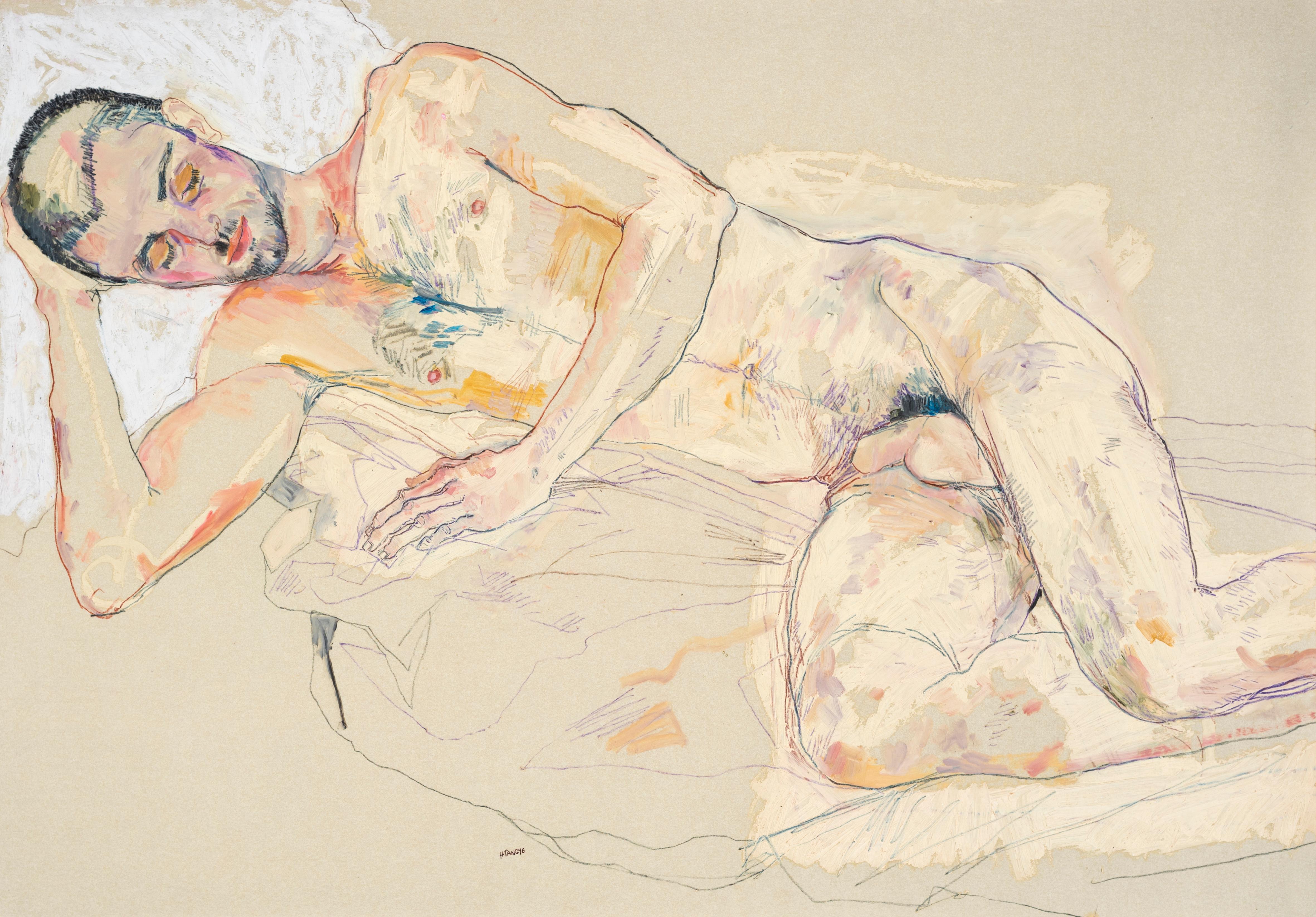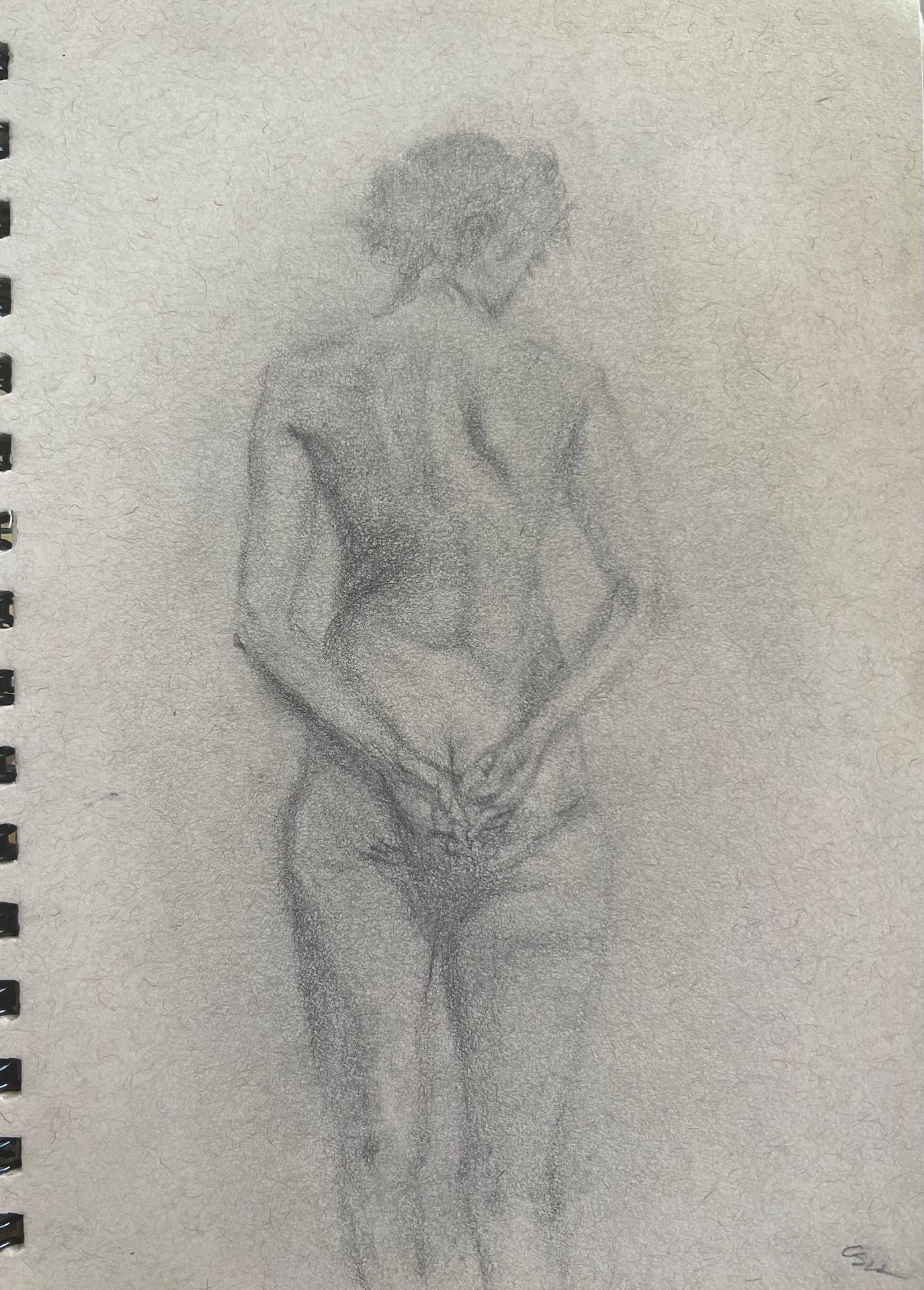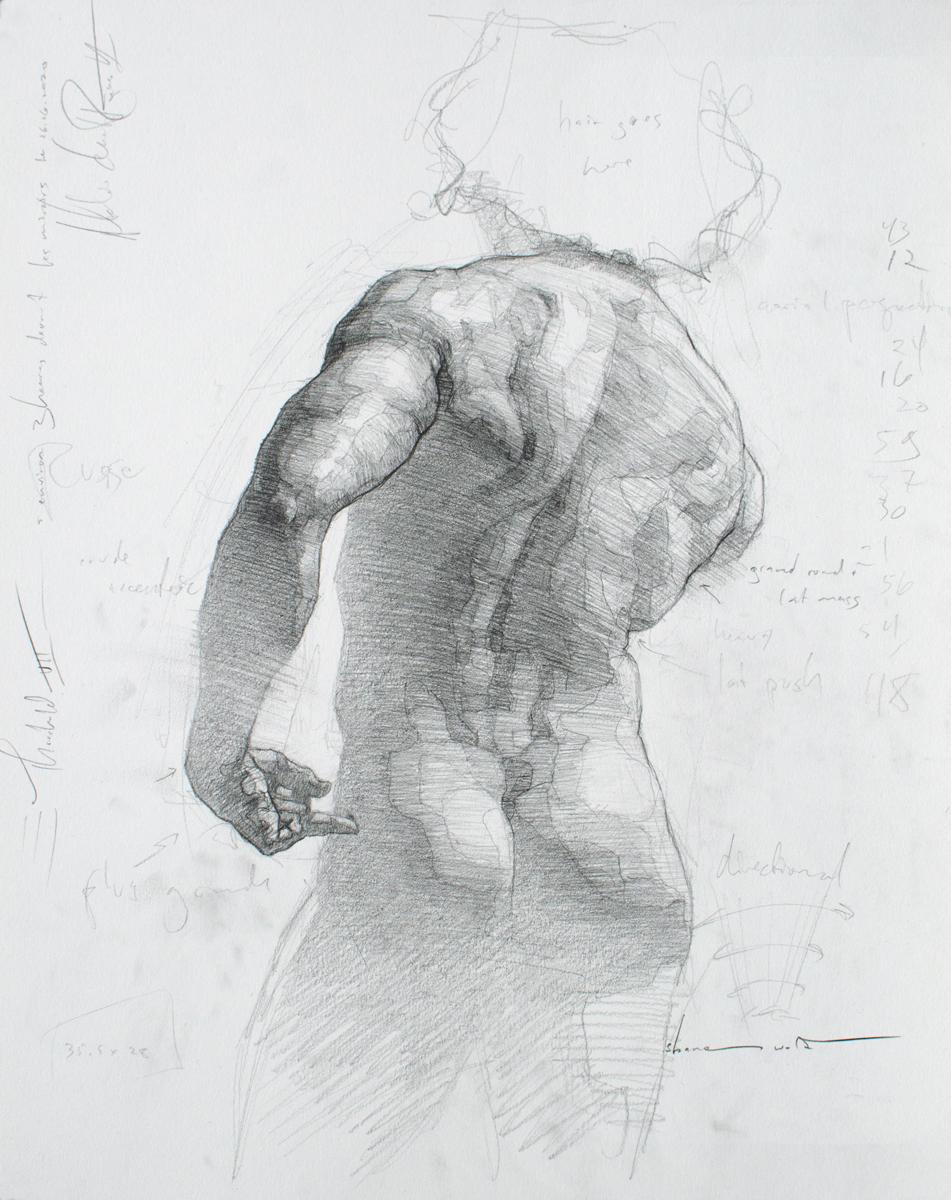Want more images or videos?
Request additional images or videos from the seller
1 of 6
Frank DuveneckStanding Male Nude1890's
1890's
About the Item
Standing Male Nude
Graphite on wove paper, c. 1890's
Unsigned
Sheet size: 9 5/16 x 6 inches
Provenance:
Rookwood Pottery Factory Collection, Cincinnati
Ira Spanierman, New York (label)
Drawings from the sketchbook are in the collections of the Munson Williams Proctor Institute in Utica, New York and the Picker Art Gallery, Colgate University, Hamilton, New York. (see photo)
A sister drawing from the same sketchbook was sold at Cowman’s Auction, October 6, 2018. Accompanied by a letter from the Spanierman, dated 1997, stating that the drawing is from a sketchbook that was held in the Rookwood Factory Collection.
Frank Duveneck
(1848-1919)
Born in Covington, Kentucky, Frank Duveneck had the birth name of Frank Decker. He became a well-trained academic painter whose work ranged from single figures in interiors to plein air canvases of figures in landscape and often included the depiction of low-life persons. His styles included Realism, Social Realism, and Impressionism, and his work was ever influenced by the dark tones and vigorous brush-strokes of the Munich style, which he learned at the Munich Academy in the 1870s. An important art historian described Duveneck's mature style as having "loose highlights brushed over ruggedly blocked-out forms emerging from a richly suggestive chiaroscuro."
He apprenticed to a church decorator, Wilhelm Lamprecht, in Cincinnati, and worked in Catholic Churches in Covington, Cincinnati, Latrobe, Pennsylvania and Quebec, Canada. At age 22, entered the Royal Academy of Munich where he intended to further his interest in church decoration but instead veered to fine-art painting on canvas. One of his most influential teachers was realist Wilhelm von Diez, and Duveneck, also impressed by the realism of French painter Gustave Courbet, became known for adopting this revolutionary approach with rich brushwork. In Munich, Duveneck shared a studio with William Merritt Chase.
Returning to Cincinnati, he painted portraits and decorated churches and also taught art classes. At first he did not gain much attention, but an exhibition in Boston in 1875 gained him good attention.
In 1875, he went back to Europe and opened an art school in Munich and also in Poling in Bavaria, and many Americans who became known as "Duveneck's Boys," studied with him. Several years later, he opened his school in Italy where he spent the winters in Florence and the summers in Venice. In 1879, he and his followers went to Venice where he began etching and briefly shared a studio with James Whistler in order to learn from him. He also did sculpture. During this period, his painting changed drastically from dark interiors with heavy, impasto paint to outdoor, plein air painting in much lighter colors giving the appearance of sunlight. Among his students was the future Impressionist painter John Henry Twachtmann, and also Elizabeth Boott, whom he married in 1886 and who died two years later.
In 1888, he returned to Cincinnati where from 1900 he taught at the Cincinnati Art Academy. He spent the summers in Gloucester, Massachusetts painting impressionistic landscapes and seascapes, and he also made many return trips to Italy, France, and Germany.
The Cincinnati Museum is the major recipient of his paintings as he took a strong, active interest in that entity.
Courtesy, Ask Art
- Creator:Frank Duveneck (1848-1919, American)
- Creation Year:1890's
- Dimensions:Height: 9.313 in (23.66 cm)Width: 6 in (15.24 cm)
- Medium:
- Period:
- Condition:
- Gallery Location:Fairlawn, OH
- Reference Number:
About the Seller
5.0
Recognized Seller
These prestigious sellers are industry leaders and represent the highest echelon for item quality and design.
Platinum Seller
These expertly vetted sellers are 1stDibs' most experienced sellers and are rated highest by our customers.
Established in 1978
1stDibs seller since 2013
711 sales on 1stDibs
Typical response time: 1 hour
Associations
International Fine Print Dealers Association
- ShippingRetrieving quote...Ships From: Fairlawn, OH
- Return PolicyA return for this item may be initiated within 10 days of delivery.
More From This SellerView All
- Preliminary Study for Cretan Dancer BronzeBy Boris Lovet-LorskiLocated in Fairlawn, OHPreliminary Study for Cretan Dancer Bronze Graphite on tracing paper, 1930 Unsigned Note: The bronze sculpture measures 24 1/2 x 33 5/8 inches and is signed and dated 1930 on the base (see image on right). It is currently being offered for sale by Taylor Graham Gallery in New York. (see photo) “The stylizing of the Cretan allegories, used in figures of animals such as horses and bulls, symbolizes the ancient power of the South. These figures reveal a spiritual sensuality as he strives to attain a symbol of the earth and universe endowed with musical values. If man is the center of his idea of life and nature, it is because of the laws that govern the movement of stars and history. The link binding his figures together has, in a sense, a Pythagorean harmony.” Salvatore Quasimodo, Milan, 1967, quoted from Bush, Boris Lover-Lorski: The Language of Time, page 12. Image size: 6 1/2 x 6 1/2 inches Condition: Repaired tear in the lower left corner (see detail photo) Boris Lovet-Lorski Lithuanian/Russian/American 1894-1973 Sculptor, painter, and printmaker, Boris Lovet-Lorski was born in Lithuania in 1894. His mother died when he was age three. His father was affluent and owned real estate. Boris grew up in a privileged environment. He studied architecture and then fine arts at the Imperial Academy of Art in Petrograd, Russia (now Saint Petersburg). Following the revolution in 1917 and its aftermath, Boris immigrated to Boston to live with his brother. In the 1920’s, his stylized, Art Deco inspired sculptures, lithographs, and paintings proved to be popular among the American elite. He exhibited frequently, holding his first solo exhibition in Boston, 1920. In the following years, Boris exhibited in New York at Marie Sterner Gallery, Jacques Seligmann Galleries and Wildenstein and Company. He lived in Paris from 1926 to 1932 where he befriended Joseph Hecht, and was exposed to the works of Pablo Picasso, Ossip Zadkine, Contantin Brancusi and Aristide Maillol. In 1932 he returned to America where he became a citizen later in the decade. Lovet-Lorski exhibited in the United States, South America, Europe and Asia. He was a member of the Society of Independent Artists (New York), the National Academy of Design (New York), and the Lotos Club (New York), as well as several Parisian salons. His work is in the permanent collections of numerous museums including the Musée Luxembourg, Bibliotèque Nationale, and the Petit Palais in France, the British Museum in London, the Metropolitan Museum in New York, the National Gallery in Washington, the Los Angeles County Museum of Art. (A more extensive list of his works in museums follows) He is considered one of the most successful and recognized sculptors of his generation. His creative influence can be seen in many of his contemporary artists. He died in Los Angeles in 1973. Regarding his iconic Art Deco sculptures of Cretan Dancers: “The stylizing of the Cretan allegories, used in figures of animals such as horses and bulls, symbolizes the ancient power of the South. These figures reveal a spiritual sensuality as he strives to attain a symbol of the earth and universe endowed with musical values. If man is the center of his idea of life and nature, it is because of the laws that govern the movement of stars and history. The link binding his figures together has, in a sense, a Pythagorean harmony.” Salvatore Quasimodo, Milan, 1967, quoted from Bush, Boris Lover-Lorski: The Language of Time, page 12. Lovet-Lorski created sculptures of the following major figures I.J. Paderewski, Prime Minister of Poland Arturo Toscanini, Italian Conductor Lilian Gish, Actress President Franklin D. Roosevelt Mrs. M. C. Niarchos, wife of Stavros Niarchos President Abraham Lincoln James Forrestal, Secretary of...Category
1930s Art Deco Nude Drawings and Watercolors
MaterialsGraphite
- Nude Seated in ChairBy William H. BaileyLocated in Fairlawn, OHNude Seated in Chair Graphite on paper, 1976 Signed and dated lower right (see photo) Exhibited: Dart Gallery, Chicago, 1976 (see photo of label) Condition: Excellent Sheet size: 14 7/8 x 11 1/8 inches Provenance: Dart Gallery, Chicago, 1976 William H. Bailey (American, b. 1930) Born in Council Bluffs, Iowa, William Bailey became a painter in styles ranging from abstraction to super-real. He earned his B.F.A. and M.F.A. at Yale University and studied with Josef Albers and also had an Alice Kimball English traveling scholarship. From 1962 to 1969, he taught at Indiana University, and from 1969, was a professor of art at Yale University. He lives and works in Branford, CT and is a member of the National Academy of Design, elected an Associate in 1983, an Academician in 1994. Recent one-person exhibitions include Robert Schoelkopf Gallery; Andre Emmerich Gallery; Robert Miller Gallery; Galleria il Gabbiana, Rome; and Galerie Claude Bernard, Paris. Selected group exhibitions include Realism Now, Vassar College Art Museum; 22 Realists, and 7 Realists, both at the Yale University Art Gallery; Decade in Review, Whitney Museum of American Art; and Contemporary American Realism Since 1960,at the Pennsylvania Academy. His work is included in the collections of the Museum of Modern Art; Museum of Fine Arts, Boston; Des Moines Art Center; Art Institute of Chicago; Arkansas Art Center; Hirshhorn Museum; Pennsylvania Academy; St. Louis Museum of Art; Whitney Museum of American Art; and Yale University Art Gallery. Publications on Mr. Bailey include "William Bailey", by Mark Strand...Category
1970s American Realist Nude Drawings and Watercolors
MaterialsGraphite
- Standing Male Nude (recto) Study of the Head of the Standing Male Nude (verso)By William Merritt ChaseLocated in Fairlawn, OHStanding Male Nude (recto) Study of the Head of the Standing Male Nude (verso) Unsigned Provenance: Estate of the artist Helen Chase Storm (the arti...Category
1870s American Impressionist Nude Drawings and Watercolors
MaterialsGraphite
- Side View Seated Female NudeBy Frank DuveneckLocated in Fairlawn, OHSide View Seated Female Nude Graphite on paper, c. 1890's Unsigned Provenance: Rookwood Pottery Factory Collection, Cincinnati Spanierman Gallery, New York (label) Drawings from the sketchbook are in the collections of the Munson Williams Proctor Institute in Utica, New York and the Picker Art Gallery, Colgate University, Hamilton, New York. Condition: Excellent Sheet size: 9 1/4 x 6 1/4 inches Frame size: 16 x 12 1/2 inches Frank Duveneck (1848-1919) Born in Covington, Kentucky, Frank Duveneck had the birth name of Frank Decker. He became a well-trained academic painter whose work ranged from single figures in interiors to plein air canvases of figures in landscape and often included the depiction of low-life persons. His styles included Realism, Social Realism, and Impressionism, and his work was ever influenced by the dark tones and vigorous brush-strokes of the Munich style, which he learned at the Munich Academy in the 1870s. Art historian Matthew Baigell described Duveneck's mature style as having "loose highlights brushed over ruggedly blocked-out forms emerging from a richly suggestive chiaroscuro." He apprenticed to a church decorator, Wilhelm Lamprecht, in Cincinnati, and worked in Catholic Churches in Covington, Cincinnati, Latrobe, Pennsylvania and Quebec, Canada. At age 22, entered the Royal Academy of Munich where he intended to further his interest in church decoration but instead veered to fine-art painting on canvas. One of his most influential teachers was realist Wilhelm von Diez, and Duveneck, also impressed by the realism of French painter Gustave Courbet, became known for adopting this revolutionary approach with rich brushwork. In Munich, Duveneck shared a studio with William Merritt Chase. Returning to Cincinnati, he painted portraits and decorated churches and also taught art classes. At first he did not gain much attention, but an exhibition in Boston in 1875 gained him good attention. In 1875, he went back to Europe and opened an art school in Munich and also in Poling in Bavaria, and many Americans who became known as "Duveneck's Boys," studied with him. Several years later, he opened his school in Italy where he spent the winters in Florence and the summers in Venice. In 1879, he and his followers went to Venice where he began etching and briefly shared a studio with James Whistler in order to learn from him. He also did sculpture. During this period, his painting changed drastically from dark interiors with heavy, impasto paint to outdoor, plein air painting in much lighter colors giving the appearance of sunlight. Among his students was the future Impressionist painter John Henry Twachtmann, and also Elizabeth Boott, whom he married in 1886 and who died two years later. In 1888, he returned to Cincinnati where from 1900 he taught at the Cincinnati Art Academy. He spent the summers in Gloucester, Massachusetts painting...Category
1890s American Impressionist Nude Drawings and Watercolors
MaterialsGraphite
- Reclining Female NudeBy Emil GansoLocated in Fairlawn, OHReclining Female Nude Charcoal on paper, c. 1933 Signed lower right (see photo) Provenance: Weyhe Gallery, New York (Ganso's dealer 1925-1941) Joseph Mark Erdelac, Cleveland, noted collector who had a large collection of Ganso works Ganso was born in Germany in 1895. At age 14, he apprenticed to a baker and then worked his way to America when he was 17. He worked in bakeries in Scranton, Pennsylvania; and Cincinnati and Akron, Ohio. By 1916, Ganso out of a job, and was living the life of a bohemian in New York City, sometimes on less than 30 cents a week.1 In 1921, Ganso painted a realistic nude on a bedsheet, and was forced by the police to remove it from an exhibition. The bedsheet with the painting was later stolen. He soon had a job baking again at $140 a month, and with time to spare for painting and study. Ganso quit baking in 1925 when a New York dealer gave him financial backing of $50 a week. Ganso prospered from his art after that. His work is in over 15 American museums, and the Print Club of Cleveland awarded him a $500 purchase prize for a wood engraving. A versatile artist, he painted a variety of subjects. (from a profile written by Clyde Singer...Category
1930s American Modern Nude Drawings and Watercolors
MaterialsGraphite
- Preparatory drawing for Figure Composition, Carmel (CA.)By E. Ambrose WebsterLocated in Fairlawn, OHPreparatory drawing for Figure Composition, Carmel (CA) Graphite on paper, 1931 Signed with the artist's initial "W" lower right corner (see photo)...Category
1930s American Modern Nude Drawings and Watercolors
MaterialsGraphite
You May Also Like
- Craig (Nude), Mixed media on Pergamenata parchmentBy Howard TangyeLocated in London, GBHoward Tangye (b.1948, Australia) has been an influential force in fashion for decades. Lecturing at London’s Central Saint Martins for 35 years, including 16 years as head of BA Wom...Category
2010s Contemporary Nude Paintings
MaterialsArchival Paper, Handmade Paper, Vellum, Pen, Pencil, Carbon Pencil, Gess...
- Seated nude, rear.By Frank DobsonLocated in East Grinstead, GBFrank Dobson seated nude in graphite with pastel highlights.Category
Early 20th Century Nude Drawings and Watercolors
MaterialsGraphite
- Seated nudeBy Frank DobsonLocated in East Grinstead, GBFrank Dobson early period graphite drawing, signed.Category
Early 20th Century Nude Drawings and Watercolors
MaterialsGraphite
- 1960s Figural Graphite Drawing by Artist Albert RadoczyBy Albert RadoczyLocated in Stone Mountain, GAExceptionally rendered graphite drawing by artist Albert Radoczy. Delicate mark-making of female figure. Signed and dated lower right. Presented in a handsome vintage giltwood frame,...Category
Mid-20th Century Abstract Figurative Drawings and Watercolors
MaterialsGraphite
- GentleBy Amrta ArtLocated in Los Angeles, CAThis is a unique Amrta Art sketch. Delicate and mysterious, Amrta has a way of making her figures feel like they are floating and moving on the page. This piece is on Strathmore Tone...Category
2010s Contemporary Nude Drawings and Watercolors
MaterialsGraphite, Archival Paper
- Threshold VIILocated in PARIS, FRShane Wolf is an American artist born in 1976 in Cincinnati. A first university career in graphic design led him to work for major French industrial brands. He then settled in Annecy...Category
21st Century and Contemporary Contemporary Figurative Drawings and Water...
MaterialsGraphite



